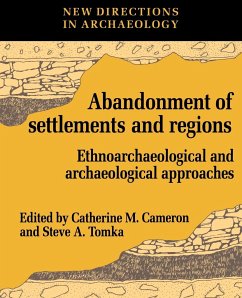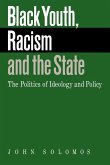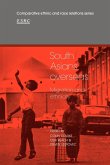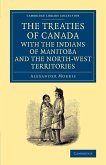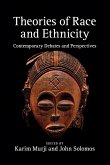All archaeological sites have been abandoned, but people abandoned sites in many different ways, and for different reasons. What they did when leaving a settlement, structure, or activity area had a direct effect on the kind and quality of the cultural remains entering the archaeological record - for example, whether tools were removed, destroyed, or buried in the ground, and building structures dismantled or left standing. This is the first book to examine abandonment as a stage in the formation of an archaeological site, and relies on ethnoarchaelogical and archaeological data from many areas of the world - North and South America, Europe, Africa, and the Near East. It documents the many complex factors surrounding abandonment both across entire regions and within settlement areas, and makes an important theoretical and methodological contribution to this area of archaeological investigation.
Table of contents:
Acknowledgements; List of tables; List of figures; Part I. Introduction: 1. Abandonment and archaeological interpretation Catherine M. Cameron; Part II. Regional Abandonment Processes: Ethnoarcheological Cases: 2. Site abandonment behaviour among transhumant agro-pastoralists: the effects of delayed curation on assemblage composition Steve M. Tomka; 3. Settlement organization and residential variability among the Raramuri Martha Graham; 4. Occupational and locational instability in arid land settlement Lee Horne; 5. Models of abandonment and material culture frequencies Susan Kent; 6. Agricultural abandonment: a comparative study in historical ecology Glenn Davis Stone; Part III. Regional Abandonment Processes: Archaelogical Cases: 7. Local abandonments and regional conditions in the North American Southwest Sarah H. Schlanger and Richard H. Wilshusen; 8. An assessment of abandonment processes in the Hohkam Classic Period of Tucson Basin Paul R. Fish and Suzanne K. Fish; 9 Regional settlement abandonment at the end of the Copper Age in the lowlands of West-Central Portugal Katina Lillios; Part IV. Abandonment Processes Within Sites: Ethnoarcheological Cases: 10. Abandonment at Zuni farming villages Nan A. Rothschild, Barbara J. Mills, T. J. Ferguson and Susan Dublin; 11. Abandonment and the production of archaeological variability at domestic sites Arthur A. Joyce and Sissel Johannssen; Part V. Abandonment Processes Within Sites: Archaeological Cases: 12. Ceramic analysis as a tool for discovering processes of Pueblo abandonment Barbara Klie Montgomery; 13. Abandonment processes in prehistoric Pueblos Ricky R. Lightfoot; 14. Household abandonment among sedentary Plains societies: behavioural sequences and consequences in the interpretation of the archaeological record Robert L. Brooks; Part VI. Conclusions: 15. Understanding abandonment processes: summary and remaining concerns Steve A. Tomka and Marc G. Stevenson.
The first archaeological book to examine abandonment as a stage in the formation of an archaeological site.
Hinweis: Dieser Artikel kann nur an eine deutsche Lieferadresse ausgeliefert werden.
Table of contents:
Acknowledgements; List of tables; List of figures; Part I. Introduction: 1. Abandonment and archaeological interpretation Catherine M. Cameron; Part II. Regional Abandonment Processes: Ethnoarcheological Cases: 2. Site abandonment behaviour among transhumant agro-pastoralists: the effects of delayed curation on assemblage composition Steve M. Tomka; 3. Settlement organization and residential variability among the Raramuri Martha Graham; 4. Occupational and locational instability in arid land settlement Lee Horne; 5. Models of abandonment and material culture frequencies Susan Kent; 6. Agricultural abandonment: a comparative study in historical ecology Glenn Davis Stone; Part III. Regional Abandonment Processes: Archaelogical Cases: 7. Local abandonments and regional conditions in the North American Southwest Sarah H. Schlanger and Richard H. Wilshusen; 8. An assessment of abandonment processes in the Hohkam Classic Period of Tucson Basin Paul R. Fish and Suzanne K. Fish; 9 Regional settlement abandonment at the end of the Copper Age in the lowlands of West-Central Portugal Katina Lillios; Part IV. Abandonment Processes Within Sites: Ethnoarcheological Cases: 10. Abandonment at Zuni farming villages Nan A. Rothschild, Barbara J. Mills, T. J. Ferguson and Susan Dublin; 11. Abandonment and the production of archaeological variability at domestic sites Arthur A. Joyce and Sissel Johannssen; Part V. Abandonment Processes Within Sites: Archaeological Cases: 12. Ceramic analysis as a tool for discovering processes of Pueblo abandonment Barbara Klie Montgomery; 13. Abandonment processes in prehistoric Pueblos Ricky R. Lightfoot; 14. Household abandonment among sedentary Plains societies: behavioural sequences and consequences in the interpretation of the archaeological record Robert L. Brooks; Part VI. Conclusions: 15. Understanding abandonment processes: summary and remaining concerns Steve A. Tomka and Marc G. Stevenson.
The first archaeological book to examine abandonment as a stage in the formation of an archaeological site.
Hinweis: Dieser Artikel kann nur an eine deutsche Lieferadresse ausgeliefert werden.

